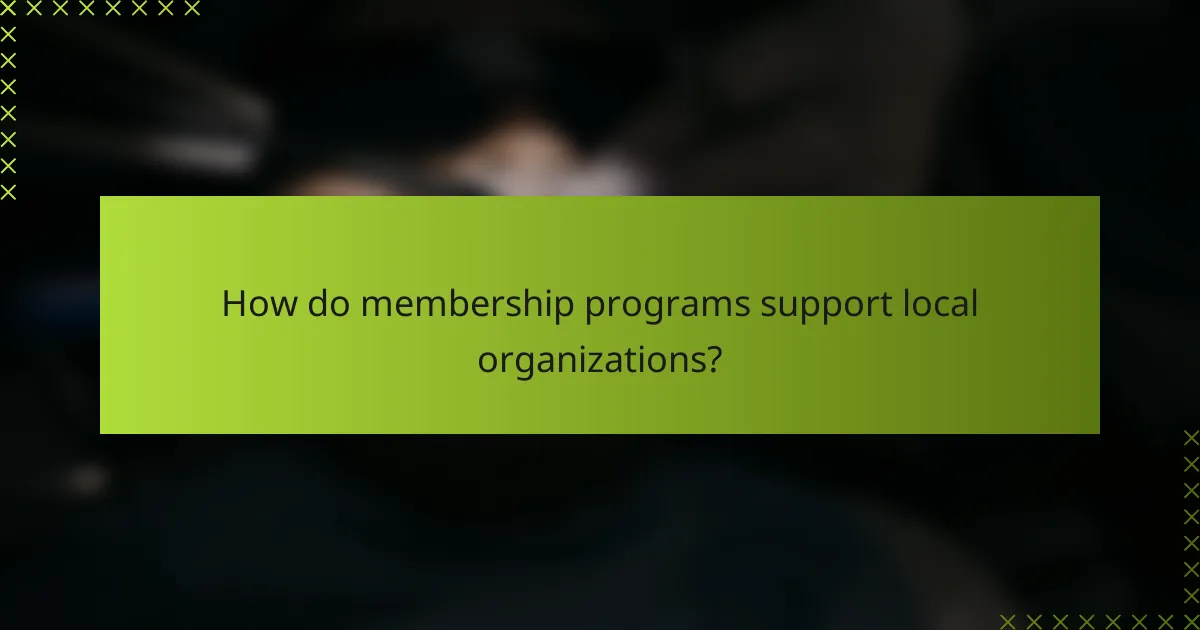Membership programs play a vital role in enhancing community strength and engagement by creating meaningful connections among members and offering structured volunteer opportunities. Through these programs, individuals can actively participate in local initiatives, contributing their skills and time to support nonprofit organizations and community projects. This collaborative effort not only fosters a sense of belonging but also strengthens the overall capacity of communities to thrive.

How can membership programs enhance community engagement?
Membership programs can significantly boost community engagement by fostering connections among members and providing structured opportunities for participation. These programs create a sense of belonging and encourage individuals to contribute actively to local initiatives.
Increased volunteer participation
Membership programs often lead to higher volunteer participation by offering clear pathways for involvement. Members are more likely to engage when they feel a sense of ownership and commitment to the organization. Providing various volunteer opportunities, such as community clean-ups or educational workshops, can attract a diverse range of participants.
To maximize participation, organizations should regularly communicate upcoming volunteer events and highlight the impact of members’ contributions. Utilizing social media and newsletters can effectively keep members informed and motivated.
Strengthened local networks
Membership programs help strengthen local networks by connecting individuals with shared interests and goals. These connections can lead to collaborations and partnerships that enhance community initiatives. Networking events, such as mixers or forums, can facilitate relationship-building among members.
Encouraging members to share their skills and resources can further solidify these networks. For example, a local business owner might offer discounts to members, fostering a supportive environment that benefits everyone involved.
Access to exclusive events
Members often gain access to exclusive events that are not available to the general public. These events can include workshops, seminars, or social gatherings that provide valuable learning and networking opportunities. Exclusive access can enhance the perceived value of membership and encourage ongoing participation.
Organizations should promote these events effectively, emphasizing the unique benefits members receive. This can create excitement and anticipation, driving further engagement within the community.
Enhanced communication channels
Effective communication is crucial for community engagement, and membership programs can establish enhanced channels for interaction. Regular updates through newsletters, social media, and dedicated forums can keep members informed and involved. This transparency fosters trust and encourages feedback.
Organizations should consider using digital platforms that allow for easy communication and collaboration among members. Tools like group chats or project management apps can streamline discussions and facilitate quicker decision-making.
Collaborative projects
Membership programs often lead to collaborative projects that harness the collective skills and resources of members. These projects can address local issues, such as environmental sustainability or community health, and provide hands-on opportunities for members to contribute meaningfully.
To initiate successful collaborations, organizations should identify common interests among members and encourage brainstorming sessions. Setting clear goals and timelines can help keep projects on track and ensure that all members feel involved in the process.

What volunteer opportunities are available through membership programs?
Membership programs often provide a variety of volunteer opportunities that enable individuals to engage with their communities. These opportunities can range from hands-on projects to roles that support nonprofit organizations, allowing members to contribute their skills and time effectively.
Community service projects
Community service projects are organized initiatives that address local needs, such as environmental clean-ups, food drives, or educational workshops. Members can participate in these projects to make a tangible impact in their neighborhoods.
To get involved, check with local membership organizations for upcoming projects. Many programs offer flexible schedules, allowing volunteers to choose times that fit their availability.
Nonprofit partnerships
Membership programs often collaborate with nonprofits to enhance their outreach and services. Volunteers can assist these organizations by providing administrative support, fundraising, or direct service to beneficiaries.
Consider reaching out to local nonprofits to explore partnership opportunities. This can be a great way to gain experience while supporting causes you care about.
Event organization roles
Many membership programs host events that require planning and execution, such as fundraisers, community fairs, or educational seminars. Volunteers can take on roles in logistics, marketing, or on-the-day coordination.
Getting involved in event organization can help you develop valuable skills in project management and teamwork. Look for training sessions or workshops offered by the program to enhance your capabilities.
Mentorship programs
Mentorship programs connect experienced individuals with those seeking guidance, often focusing on career development or personal growth. Members can volunteer as mentors to share their knowledge and support others in their journeys.
To participate, inquire about mentorship opportunities within your membership program. Being a mentor can be rewarding and help build a stronger community through shared experiences.

How do membership programs support local organizations?
Membership programs provide essential support to local organizations by offering financial resources, volunteer manpower, and community engagement opportunities. These programs help strengthen community ties and enhance the capacity of organizations to serve their missions effectively.
Funding and resources
Membership programs often generate funding through membership fees, donations, and grants. This financial support can be crucial for local organizations, allowing them to cover operational costs, invest in new projects, or expand existing services.
In addition to direct funding, membership programs can provide access to resources such as training materials, networking opportunities, and shared facilities. Organizations can leverage these resources to improve their effectiveness and reach a wider audience.
Volunteer recruitment
Membership programs play a vital role in recruiting volunteers by creating a sense of belonging and purpose. Individuals who join these programs are often motivated to contribute their time and skills to local causes, enhancing the volunteer pool available to organizations.
Effective recruitment strategies include hosting events, providing incentives, and showcasing the impact of volunteer efforts. Organizations should clearly communicate the benefits of volunteering, such as skill development and community connection, to attract and retain volunteers.
Skill-sharing initiatives
Skill-sharing initiatives within membership programs enable members to exchange expertise and knowledge, benefiting both individuals and organizations. These initiatives can take the form of workshops, mentorships, or collaborative projects that foster learning and growth.
Organizations can facilitate skill-sharing by identifying the strengths of their members and creating opportunities for collaboration. This not only enhances the capabilities of the organization but also empowers members by allowing them to contribute their unique skills to the community.

What are the benefits of joining a membership program?
Joining a membership program offers various benefits, including enhanced community engagement, access to resources, and opportunities for personal and professional growth. Members often enjoy exclusive perks that can strengthen their connection to the community and improve their skills.
Networking opportunities
Membership programs provide valuable networking opportunities that can lead to meaningful connections. Members can meet like-minded individuals, industry professionals, and potential collaborators through events, workshops, and online forums.
To maximize networking, actively participate in events and engage with others. Consider joining committees or volunteer groups to expand your reach and build relationships within the community.
Skill development
Joining a membership program often includes access to resources that promote skill development. Members can participate in workshops, seminars, and peer-to-peer learning sessions that enhance their abilities in specific areas.
Focus on identifying the skills you want to develop and seek out relevant programs or events. Many organizations offer mentorship opportunities that can further support your growth and provide guidance from experienced professionals.
Access to training
Membership programs frequently offer exclusive access to training sessions and educational resources. These can range from online courses to in-person workshops, often at reduced rates for members.
When considering a membership, review the training offerings to ensure they align with your interests and career goals. Take advantage of these resources to stay updated on industry trends and best practices.
Discounts on services
Many membership programs provide discounts on various services, such as professional development courses, conferences, and even local businesses. These savings can significantly reduce your overall costs while enhancing your experience.
Before joining, investigate the specific discounts available to members. This can help you determine the overall value of the membership and whether it meets your needs and budget.

How do I choose the right membership program?
Choosing the right membership program involves aligning your personal or organizational goals with the benefits offered by the program. Consider what you hope to achieve and how the program can support those objectives.
Assess organizational goals
Begin by clearly defining your organizational goals. Are you looking to enhance community engagement, increase volunteer participation, or strengthen local partnerships? Understanding these goals will help you identify which membership programs can effectively support your mission.
Next, evaluate how each program aligns with your objectives. For instance, if your goal is to boost volunteer opportunities, look for programs that emphasize volunteer training and support. This alignment ensures that your efforts will be directed toward meaningful outcomes.
Evaluate membership benefits
Examine the specific benefits each membership program offers. Common benefits may include access to resources, networking opportunities, training sessions, and promotional support. Create a comparison chart to visualize these benefits against your goals.
Consider the value of these benefits in relation to any membership fees. For example, if a program costs around $100 annually but offers extensive training and networking opportunities, it may be worth the investment. Always weigh the potential return on investment against the costs involved.
